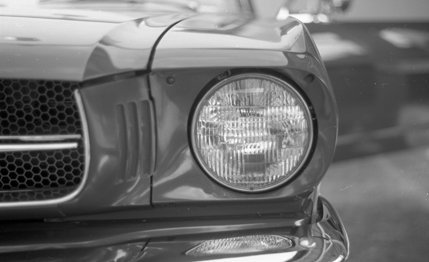Crankshaft design for this engine became the subject of a special study. The crank is made of precision-cast alloy iron and runs in five main bearings. About 70% of the total unbalanced couple is balanced by counterweights on the crankpin webs, and the remaining 30% is balanced by two external counterweights—one mounted in front of the timing sprocket and the other integrally with the flywheel. In most previous passenger car applications of this engine, the fourth harmonic unbalance occurs beyond the normal speed range. But on the high-performance 289 the fourth harmonic comes within its 7000-rpm range, so the vibration damper developed for the Indianapolis engine, with enlarged rubber contact areas and tuned for higher crankshaft speeds, was adapted. The high-performance 289 also has the cross-bolted crankcase from the Indy engine, plus -a number of special design features such as high-tensile strength connecting rods, copper-lead alloy bearing shells, chrome-plated valve stems, mechanical valve lifters, and a high-lift, high-overlap camshaft. The cylinder heads give a compression ratio of 10.5-to-one, and the air intake system consists of a low-restriction air cleaner, an opera-throat four-barrel carburetor, and direct manifold passages. The exhaust system boasts individual headers merging into twin tail pipes. Power output is an impressive 271 bhp at 6000 rpm with a maximum torque of 312 lbs-ft at 3400 rpm. Naturally this unit can be tuned still further for racing purposes by such patent medicines as Dr. Shelby’s Cobra Elixir (or imitations available from your local Performance Drugstore). Over 300 bhp may be reached without impairing engine reliability. Specific output of the hottest production model Mustang engine is 0.95 bhp per cu in, as against 0.73 for the standard 289-cubic-inch power unit.
In the Mustang, the 289 in stock form gives bushy-tailed performance and encourages enterprising driving methods, greatly aided by the precise gate and well-chosen ratios and excellent synchromesh of the four‑speed transmission. American manufacturers, be it GM, Ford or Chrysler, are really spoiling us with their faultless synchro systems, and the bad examples from abroad are becoming harder and harder to endure.
For some obscure reason, the 260-cu in V-8 can only be supplied with the 3-speed all-synchro transmission (or the 3-speed automatic). The 289 comes with either the 4-speed manual or the 3-speed automatic and the all-synchro four-speed gearbox is mandatory with the high-performance V-8.
|
|
| |
Floor-control is used for all transmissions; a rugged lever with a large spherical knob for the manual options and a T-handle for the automatic. This new automatic, designated the C-4, was introduced on the 1964 Fairlane and Mercury Comet series. The selector quadrant has six positions: P-R-N-D1-D2-L. Starting off in D, gives first gear, while D2 does not engage low gear so as to reduce the risk of wheelspin on slippery surfaces. L position works as a hold switch for low gear. The lever can be moved to L at any speed, but over about 15 mph it engages intermediate instead of low, and braking effect is mainly dependent upon the good old friction materials.
The C-4 consists of an 11-1/4 -in diameter torque converter with a maximum torque multiplication of 2.40-to-one (at stall) and an input torque capacity of 275 lbs-ft. The converter works in combination with two sets of planetary gears engaged by one-way disc clutches and locked by brake bands, with a 2.46-to-one first and a 1.46-to-one intermediate. Full-throttle shift points are about 40 and 70 mph, but acceleration is improved by holding Low up to 50 mph. There’s no intermediate hold device. Reverse ratio is 2.20 to one. The C-4 automatic weighs only 145 lbs complete, mainly because the main castings are made of aluminum.
Both three-speed manual transmissions have greater mechanical efficiency than the automatic, and the all-synchro version (as used with the 260 V-8) is pleasant enough to use. But why Ford won’t supply a synchromesh first with the less powerful six-cylinder engine, which needs bottom gear more frequently, is a mystery to us. True, the torque of the 170 six is so substantial as to make second-gear starts relatively easy, but that doesn’t explain why 6-cylinder Mustang drivers have to learn double-clutching before they can engage first gear while in motion. Possibly Ford’s market research indicates that everybody who is interested in acceleration buys a V-8 and four-on-the-floor. And those second-gear starts, by the way, have been made possible by using a lower shorter intermediate gear than the all-synchro three-speed box:
| Non-synchro | All- | |
| 1st | synchro | |
| 1st | 3.29 | 2.79 |
| 2nd | 1.83 | 1.70 |
| 3rd | 1.00 | 1.00 |
Understandably, the four-speed transmission also has different ratios depending on whether it’s coupled to a “170” six or a “289” V-8:
| 170 Six | 289 V-8 | |
| 1st | 3.16 | 2.78 |
| 2nd | 2.21 | 1.93 |
| 3rd | 1.41 | 1.36 |
| 4th | 1.00 | 1.00 |
For the six-cylinder engines, the driveshaft is a shortened version of the Falcon’s; for the V-8 models it’s a shortened Fairlane shaft. Final drives are lifted freely from other lines—with six-cylinder engines the ring gear and pinion are standard Falcon, with 260 and 289 V-8s they are standard Fairlane, and with the high-performance “289” they are of Galaxie origin.
The differential housing for the Falcon gears is made of malleable iron with an integral carrier—the other models use a pressed steel housing with removable differential carrier. Ford’s Equa-Lock limited-slip differential will be optional with all power-team combinations.
View Photos
View Photos


Leave a Reply